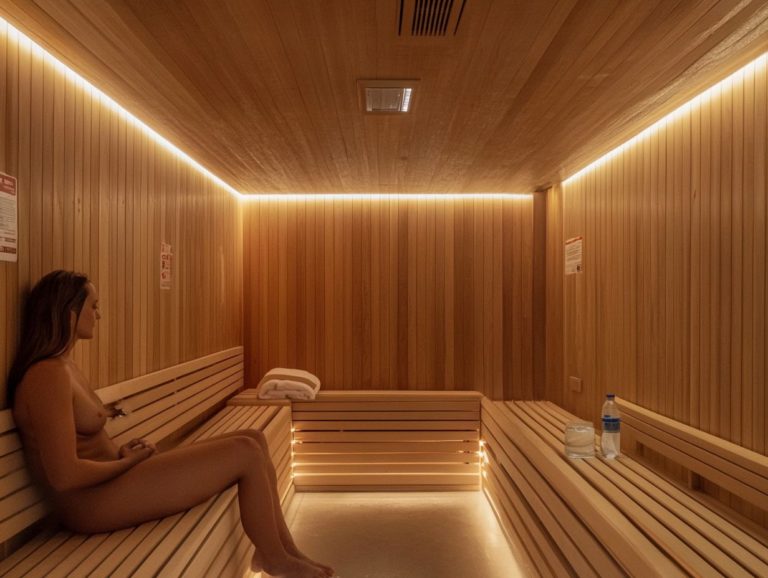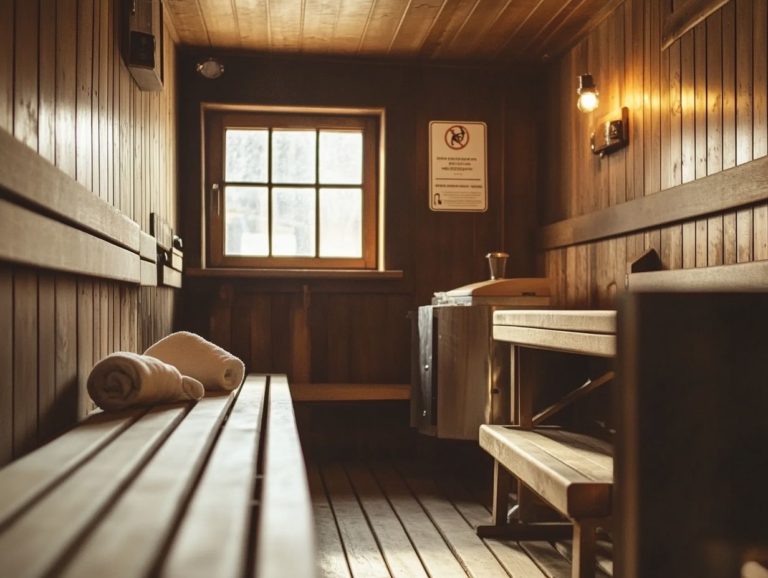5 Essential Sauna Safety Checklists
Ensuring your sauna is safe and enjoyable is paramount for a truly relaxing experience, especially when considering factors like fire safety.
This article delves into five essential safety checks you should perform to keep your sauna in impeccable condition. From monitoring temperature and humidity to inspecting electrical components, these steps are crucial for preventing accidents and enhancing your well-being.
It also highlights the benefits of regular safety checks, the potential risks involved, and the emergency procedures you should be prepared to follow.
Jump in now to learn how to maintain a safe sauna environment!
Contents
- Key Takeaways:
- 1. Check the Temperature and Humidity Levels
- 2. Make Sure the Sauna is Properly Ventilated
- 3. Inspect the Sauna’s Electrical Components
- 4. Check for Any Signs of Damage or Wear and Tear
- 5. Ensure Proper Use of Sauna Accessories
- What Are the Benefits of Regular Sauna Safety Checks?
- Frequently Asked Questions
- What are the 5 essential sauna safety checklists?
- Why is proper ventilation important in a sauna?
- How can I control the temperature in a sauna?
- Why is it important to use a timer in a sauna?
- What precautions should I take for proper hydration in a sauna?
- Why is it important to follow the manufacturer’s instructions for sauna usage?
Key Takeaways:
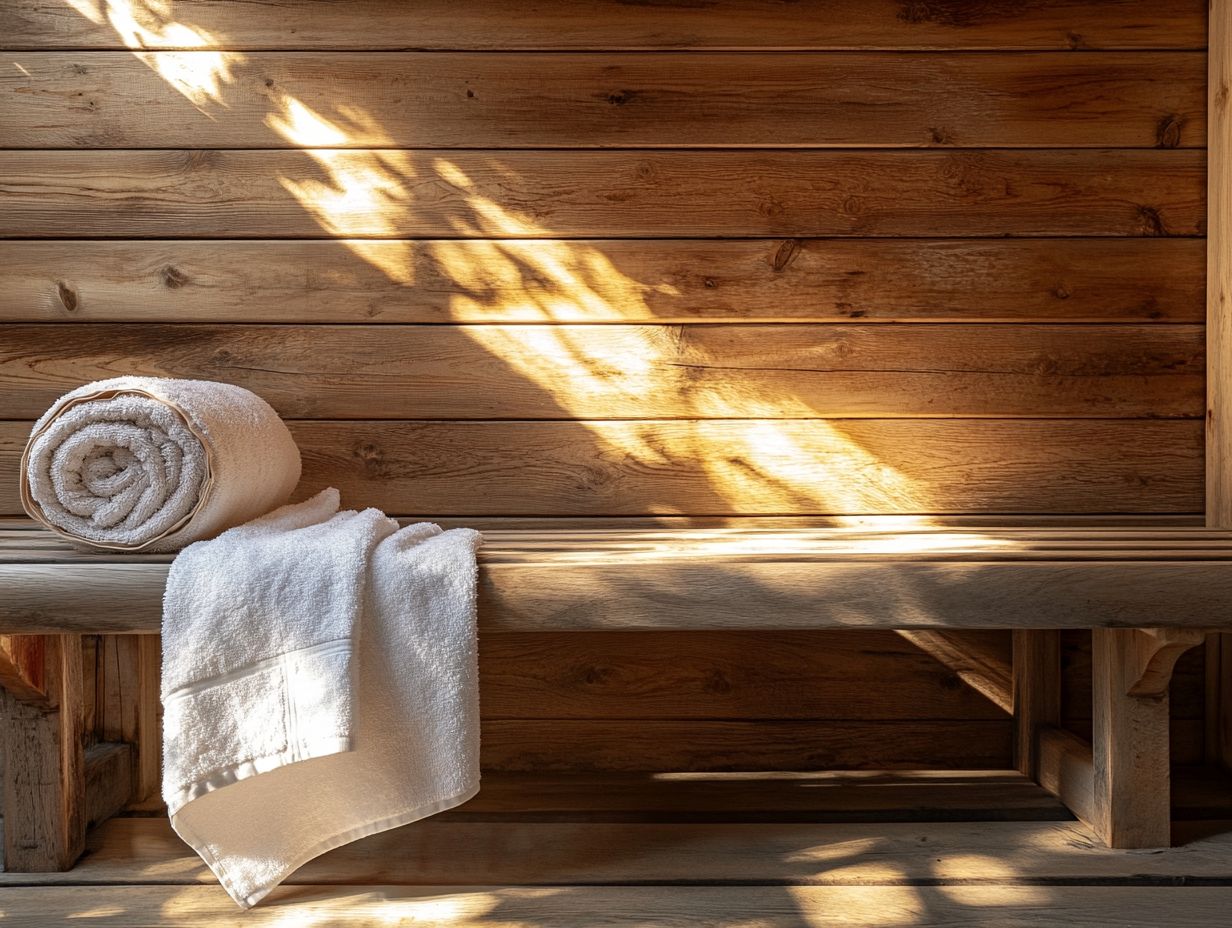
- Regularly check temperature and humidity levels for a safe experience.
- Ensure proper ventilation for a healthy sauna environment.
- Inspect electrical components to avoid hazards.
1. Check the Temperature and Humidity Levels
It’s essential to maintain the right temperature and humidity levels in a sauna for your comfort and safety. This maximizes the incredible health benefits of sauna use and keeps you feeling good.
For the optimal sauna experience, aim for a temperature range of 150 F to 195 F (65 C to 90 C). Keep humidity levels between 10% and 20% for a traditional sauna. This perfect balance can enhance your relaxation, promote cardiovascular health, and support detoxification by encouraging sweat production.
To maintain these ideal conditions, make it a habit to check the temperature and humidity using a thermometer and hygrometer. Adjust as needed to stay within those parameters. And remember, to counter fluid loss from sweating, it’s vital to hydrate before you step in, sip water during your session, and rehydrate afterward. This ensures your body remains balanced and revitalized.
2. Make Sure the Sauna is Properly Ventilated
Good ventilation is crucial for hygiene and safety in your sauna. It helps regulate temperature and remove excess humidity.
By employing methods such as installing dedicated ventilation systems, you not only enhance air circulation but also reduce the accumulation of heat and moisture that can lead to discomfort or even health risks. Regular maintenance inspections are vital for spotting potential issues that could disrupt airflow.
Using these tips, sauna enthusiasts like you can ensure a pleasant experience while adhering to safety protocols that protect everyone involved. For a comprehensive understanding, consider exploring sauna safety: a holistic approach. Ultimately, effective ventilation is crucial for maintaining an inviting atmosphere that fosters relaxation and well-being.
3. Inspect the Sauna’s Electrical Components
Regular inspections of your sauna’s electrical components are essential to prevent hazards and ensure overall fire safety, thereby protecting both you and your environment.
Focus on key components like heaters, wiring, and thermostats during these inspections. Look out for signs of wear and tear, such as frayed wires, corrosion at connections, or any unusual sounds coming from the heater. It s also crucial to check for signs of overheating. Discoloration or burning smells can be telltale indicators. Making sure the heating elements are functioning properly not only elevates your sauna experience but also reduces the risk of failures.
Hire a qualified technician for regular maintenance. This keeps your sauna in top shape and helps avoid electrical issues later.
4. Check for Any Signs of Damage or Wear and Tear
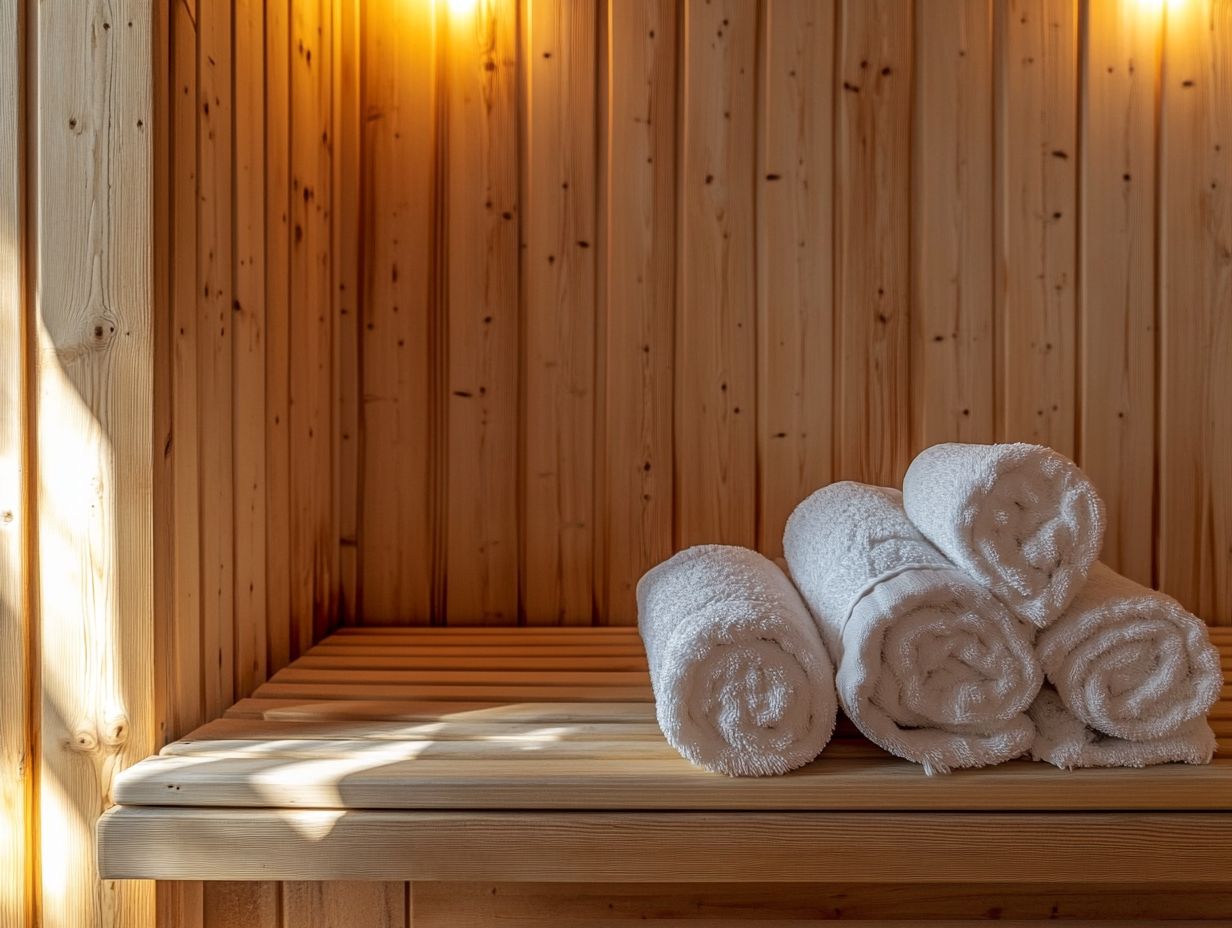
Identifying signs of damage or wear and tear in a sauna is crucial for your safety and the longevity of your investment. Neglecting these issues could lead to more significant problems down the line.
Regularly check for visible cracks in the wood, as they may compromise the structure, along with any signs of moisture buildup that could suggest a leak. Malfunctioning heaters pose serious risks, so ensure they operate correctly. Being proactive about these early warnings allows for timely repairs, helping you avoid potential hazards or costly replacements.
Incorporating regular maintenance inspections into your sauna care routine should be a priority. This approach reinforces a safety mantra that values user well-being and extends the lifespan of the sauna, ensuring a relaxing and enjoyable experience every time you step inside. Additionally, it’s important to consider sauna safety and understanding emotional needs for a holistic experience.
5. Ensure Proper Use of Sauna Accessories
Properly utilizing sauna accessories is crucial not just for elevating your sauna experience, but also for upholding fire safety and hygiene standards, ultimately safeguarding the well-being of everyone involved.
You ll find a diverse range of sauna accessories designed to meet these essential needs, from vital safety equipment like fire extinguishers to specialized cleaning products aimed at keeping your sauna environment pristine.
Always ensure that fire extinguishers are easily accessible and routinely checked to adhere to safety regulations. Use cleaning products according to the guidelines to avoid any residue buildup that could compromise sanitation.
Instruments such as thermometers (tools that measure temperature) and hygrometers (tools that measure humidity) are essential for monitoring your sauna s conditions. This helps maintain optimal temperature and humidity levels for a safe and enjoyable experience.
By prioritizing the proper use of these accessories, you can significantly enhance both safety and hygiene within your sauna space.
What Are the Benefits of Regular Sauna Safety Checks?
Regular sauna safety checks offer a multitude of benefits, such as lowering fire risk, utilizing fire extinguishers, enhancing user comfort, and amplifying health benefits. They ensure your sauna experience is both safe and enjoyable.
Inspections help you spot potential hazards quickly, like malfunctioning equipment or poor ventilation. Keeping optimal conditions in check extends your sauna’s lifespan, minimizing the chance of costly repairs or replacements. For those needing assistance, knowing how to properly handle sauna repairs is crucial. Consistent safety assessments foster a culture of awareness and responsibility among users.
This proactive approach will skyrocket your satisfaction and instill a sense of trust in the facility, ensuring you feel secure and comfortable every time you step into that soothing heat.
What Are the Potential Risks of Using a Sauna?
While saunas offer a wealth of health benefits, they also come with certain risks, including electrical hazards and fire dangers, especially if you don t follow safety protocols diligently.
Staying inside for too long without taking breaks may lead to overheating and dehydration. Recognizing the warning signs of overheating, such as dizziness or excessive sweating, is essential.
To safeguard against these risks, always hydrate by drinking water before and after your sauna session. Regularly inspect the sauna equipment to prevent malfunctions that could lead to injury.
Establish a clear emergency plan know how to turn off power sources and familiarize yourself with the nearest medical assistance. This significantly enhances your safety and gives you peace of mind during your sauna experience.
Start your sauna safety checks today to ensure a safe and enjoyable experience!
How Often Should a Sauna Be Inspected for Safety?

To ensure optimal safety, make it a priority to conduct regular inspections of your sauna at least once every six months. This way, you can confirm that all components are functioning correctly and safely for everyone who uses it.
However, keep in mind that this timeline may need to adjust based on how frequently you use your sauna. If it sees a lot of action, consider checking it every three to four months instead.
During these inspections, pay special attention to key components like the heating elements, electrical wiring (the wires that power your sauna), and ventilation systems. These elements are crucial for both performance and safety.
By embracing a consistent maintenance routine that prioritizes safety, you can prevent potential hazards and maintain a serene environment. This ensures that every sauna session is both enjoyable and secure.
What Are the Common Safety Measures to Follow in a Sauna?
Common safety measures in a sauna include adhering to established safety guidelines, maintaining proper hygiene, and ensuring family supervision, particularly if children are involved.
You can significantly enhance safety by implementing additional precautions such as installing smoke detectors, utilizing safety locks on sauna doors, and ensuring that everyone stays properly hydrated. Be aware of potential hazards like overheating or dehydration, which can easily occur if users linger too long inside. For more insights, check out sauna safety and flexibility.
Educating your family and friends about these risks, along with establishing clear safety protocols, can greatly help prevent accidents. Regular discussions about sauna usage and its associated dangers are essential for fostering a proactive safety culture, especially when considering sauna safety in different environments.
What Are the Emergency Procedures in Case of an Accident in the Sauna?
Having a clear emergency plan in place is vital for effectively responding to any accidents in the sauna. This includes knowing how to use fire extinguishers and ensuring safe evacuation for all users.
Your plan should be carefully planned to address types of emergencies that could happen, making sure everyone is clear on their roles and responsibilities during these critical moments. Regular training sessions are essential for all users.
Familiarity with procedures can significantly reduce panic and confusion when it counts most. Documenting safety protocols and placing them in a designated, easily accessible area serves as a quick reference and reinforces their importance.
Establish a system for routine drills to solidify everyone s knowledge and confidence, ensuring they re well-prepared for any unforeseen events.
How Can One Maintain Sauna Safety in the Long Run?
Maintaining sauna safety over the long haul demands your commitment to regular maintenance inspections, adherence to safety protocols, and a keen focus on sauna hygiene.
To achieve this effectively, establishing a reliable maintenance schedule is crucial. This way, you can ensure that all components are routinely checked for functionality and cleanliness.
Providing thorough training for users on proper sauna etiquette and emergency procedures will significantly reduce risks and enhance overall safety. It’s essential to regularly update safety equipment to stay ahead of potential hazards.
Tapping into community resources can be invaluable; insights from professionals like Jari Ristola and Paul Hackett offer expert tips on best practices and innovative solutions to further strengthen your safety measures.
Frequently Asked Questions
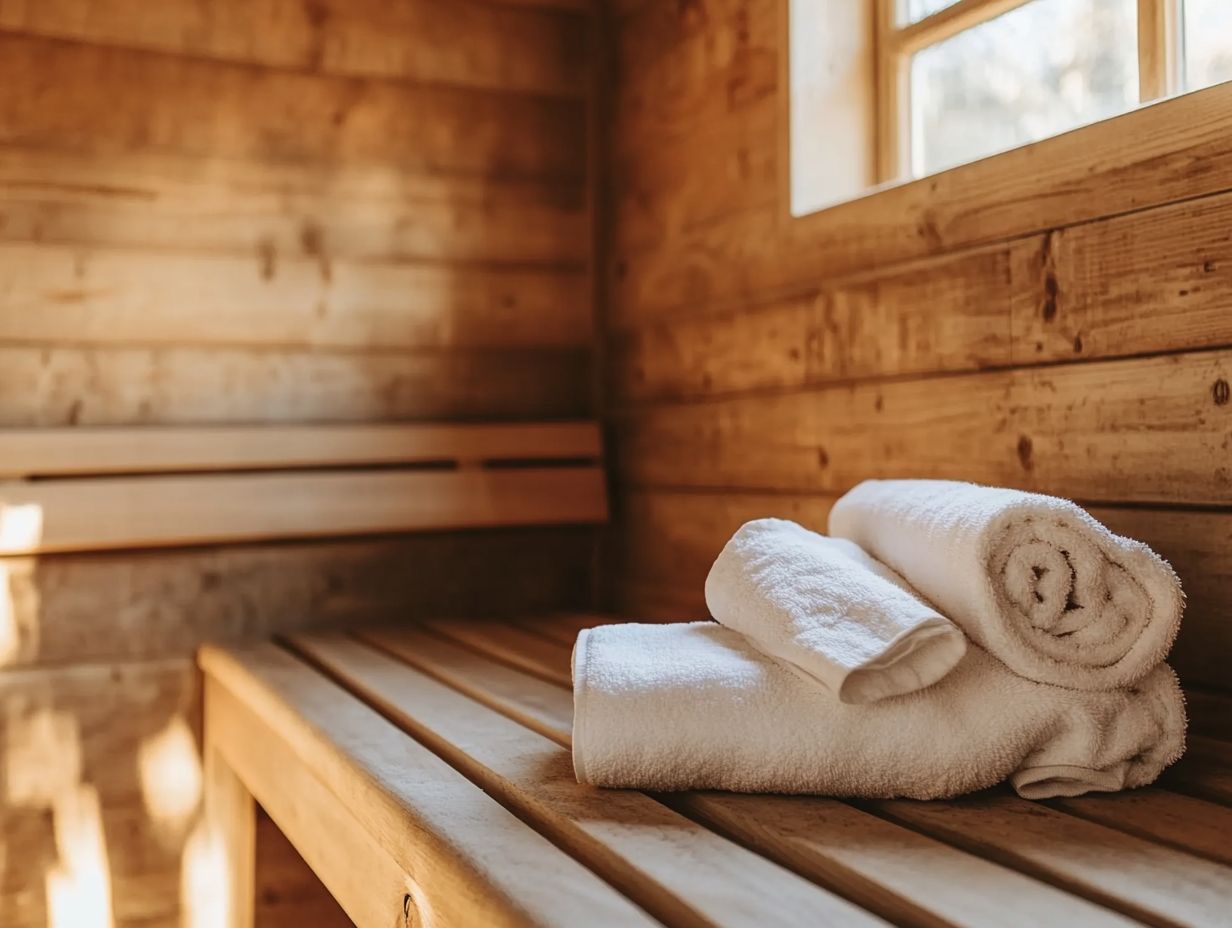
What are the 5 essential sauna safety checklists?
Here are the 5 essential safety checklists every sauna user should follow: proper ventilation, temperature control, timer usage, proper hydration, and following manufacturer’s instructions.
Why is proper ventilation important in a sauna?
Proper ventilation is important in a sauna to ensure that fresh air is continuously circulating and carbon monoxide is being properly vented out. This helps prevent health risks such as dizziness, headaches, and even carbon monoxide poisoning.
How can I control the temperature in a sauna?
Most saunas have temperature controls. Adjust the heat to make your session comfortable, and always keep an eye on the temperature to ensure it stays safe.
Why is it important to use a timer in a sauna?
A timer helps limit your sauna session to the recommended duration. This prevents overheating and reminds you to take necessary breaks and hydrate.
What precautions should I take for proper hydration in a sauna?
Staying hydrated is vital for a safe and enjoyable sauna experience! Drink plenty of water before, during, and after your session. Avoid alcohol and caffeine as they can lead to dehydration.
Why is it important to follow the manufacturer’s instructions for sauna usage?
Each sauna has unique instructions and safety guidelines. Reading and following the manufacturer’s instructions ensures you use the sauna safely and effectively.


